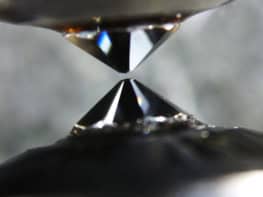
Plastics containing carbon and hydrogen monomers can be highly flammable, and once they ignite, they produce flammable gases that can fuel a fire further. For this reason, many materials in this class – including polystyrene, one of the world’s most widely-used plastics – cannot be employed in building construction unless they are made flame-retardant or concealed behind barriers such as drywall, sheet metal or concrete.
Now, however, researchers in Spain have found that a polystyrene that incorporates ultrafine particles of iron in a mesoporous silica matrix is much less likely to burst into flames or emit smoke when heated. The researchers’ technique, which also slightly increases the glass transition temperature of polystyrene, might be used to improve the thermal-oxidative stability and fire retardancy of polymers in general. This is important because accidentally-ignited foamed polystyrene materials have led to serious incidents in the past, including fires at Dusseldorf International Airport and in the Channel Tunnel.
Nanofillers improve thermal stability and fire-retardant properties
Past research has shown that polystyrene’s thermal stability and fire-retardant properties improve when nanofillers are incorporated into the material. In one previous work, De-Yi Wang of the IMDEA Materials Institute in Madrid and colleagues showed that a mesoporous silica known as SBA-15 is a particularly good candidate in this respect thanks to its tuneable pores that can be functionalized with other compounds. In polystyrene that contained SBA-15 modified with cobalt oxide (Co3O4), for example, volatile organic chemicals produced when the composite material was heated became trapped in the pores and were then only released gradually – improving the material’s thermal stability.
In their new work, Wang and colleagues began by adding dopamine hydrochloride to powdered SBA-15 and reacting the solution for 12 hours. After that time the dopamine polymerized into polydopamine (PDA). They cleaned and filtered the resultant product (denoted by SBA-15@PDA) before drying it at 80°C overnight.
The team then added an aqueous solution of ferrous nitrate – Fe(NO3)3 – to the SBA-15@PDA and mixed the two components for 24 hours using a magnetic stirrer. This ensured that the Fe3+ ions had completely diffused into the pores of the SBA-15 and had coordinated with the PDA structure. After several further processing steps, they hot-pressed the composite SBA-15@PDA@Fe into different shapes so that they could test its thermal and combustive behaviour.
Analysing volatile organics and combustion behaviour
The researchers analysed the volatile organics generated after subjecting their test shapes to heat. They did this using Fourier transformation infrared spectroscopy in a thermogravimetric analyser. They also studied the material’s combustion behaviour by measuring the so-called limiting oxygen index (LOI) and by using the cone calorimeter test (CCT), which involves heating up the samples in a crucible from room temperature to 800°C at a rate of 10°C per minute.

Composite chitin film could replace plastic packaging
Compared to simple polystyrene composites containing only SBA-15, those containing SBA-15@PDA@Fe had a stronger affinity for aerobic volatiles than anaerobic ones, the researchers report. This has the effect of delaying the release of oxidatively decomposed products and thus improves thermal-oxidation stability. What is more, the SBA-15@PDA@Fe improved the LOI (by 1.7%), meaning the altered material produces less smoke. The glass transition temperature of the material (that is, the temperature at which it goes from being a solid to one that flows) was also around 10°C higher than pure polystyrene, again showing that the composite is more thermally stable.
The researchers report their work in Nanotechnology, which (like Physics World) is published by IOP Publishing.



